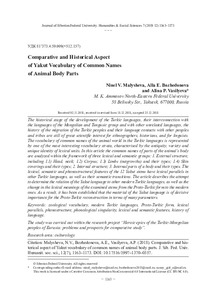Comparative and Historical Aspect of Yakut Vocabulary of Common Names of Animal Body Parts
Скачать файл:
URI (для ссылок/цитирований):
https://elib.sfu-kras.ru/handle/2311/109224Автор:
Malysheva, Ninel V.
Bozhedonova, Alla E.
Vasilyeva, Alina P.
Малышева, Н.В.
Божедонова, А.Е.
Васильева, А.П.
Дата:
2018Журнал:
Журнал Сибирского федерального университета. Гуманитарные науки. Journal of Siberian Federal University. Humanities & Social Sciences; 2018Аннотация:
The historical stage of the development of the Turkic languages, their interconnection with the languages of the Mongolian and Tungusic group and with other unrelated languages, the history of the migration of the Turkic peoples and their language contacts with other peoples and tribes are still of great scientific interest for ethnographers, historians, and for linguists. The vocabulary of common names of the animal world in the Turkic languages is represented by one of the most interesting vocabulary strata, characterised by the antiquity, variety and unique identity of lexical units. In this article the common names of parts of the animal’s body are analyzed within the framework of three lexical and semantic groups: 1. External structure, including 1.1) Head, neck; 1.2) Corpus; 1.3) Limbs (outgrowths) and their types; 1.4) Skin coverings and their types; 2. Internal structure; 3. Internal parts of a body and their types. The lexical, semantic and phonostructural features of the 12 Yakut stems have lexical parallels in other Turkic languages, as well as their semantic transitions. The article describes the attempt to determine the relation of the Yakut language to other modern Turkic languages, as well as the change in the lexical meanings of the examined stems from the Proto-Turkic form to the modern ones. As a result, it has been established that the material of the Yakut language is of decisive importance for the Proto-Turkic reconstruction in terms of many parameters Исторический этап развития тюркских языков, их взаимосвязь с языками монгольской, тунгусо-маньчжурской группы языков и с другими неродственными языками,
история переселения тюркских народов и их языковые контакты с другими народами и племенами до сих пор вызывают большой научный интерес как у этнографов,
историков, так и у лингвистов. Лексика общих названий животного мира в тюркских
языках представляется одним из наиболее интересных пластов словарного состава,
отличающихся древностью, многообразием и самобытностью лексических единиц.
В настоящей статье рассматриваются общие названия частей тела животных
в рамках трех лексико-семантических групп (далее – ЛСГ): 1. Внешнее строение, в том
числе 1.1) голова, шея; 1.2) туловище; 1.3) конечности (выросты) и их виды; 1.4) покров
и его виды. 2. Внутреннее строение. 3. Внутренние органы и их виды. Выявляются
лексико-семантические, фоноструктурные особенности 12 якутских основ, имеющих
лексические параллели в других тюркских языках, а также их семантические переходы. В статье предпринимается попытка определения отношения якутского языка
к другим современным тюркским языкам, а также прослеживаются изменения лексических значений рассматриваемых основ от пратюркской формы к современным.
В работе устанавливается, что по многим параметрам материал якутского языка
имеет решающее значение для пратюркской реконструкции

